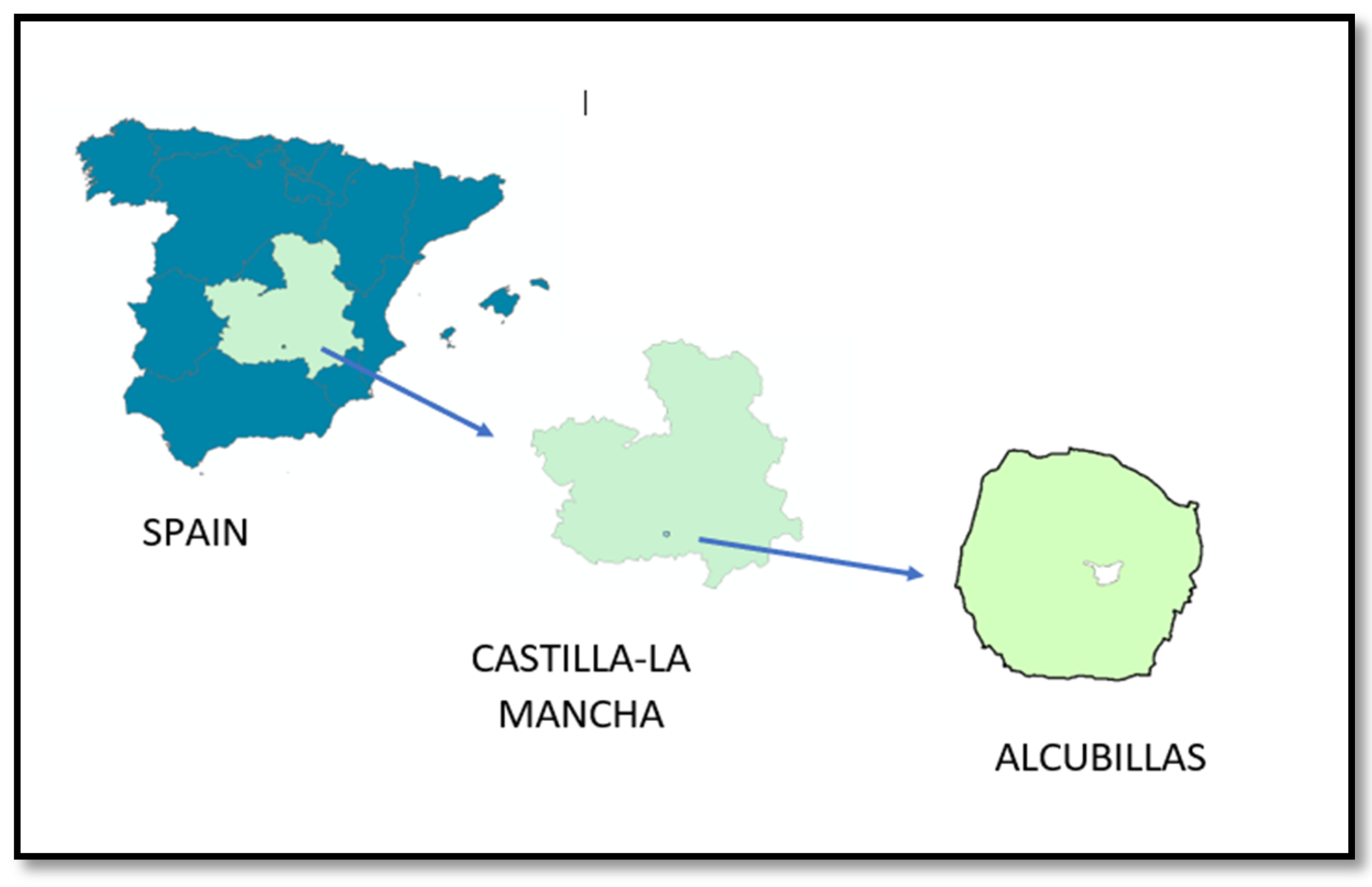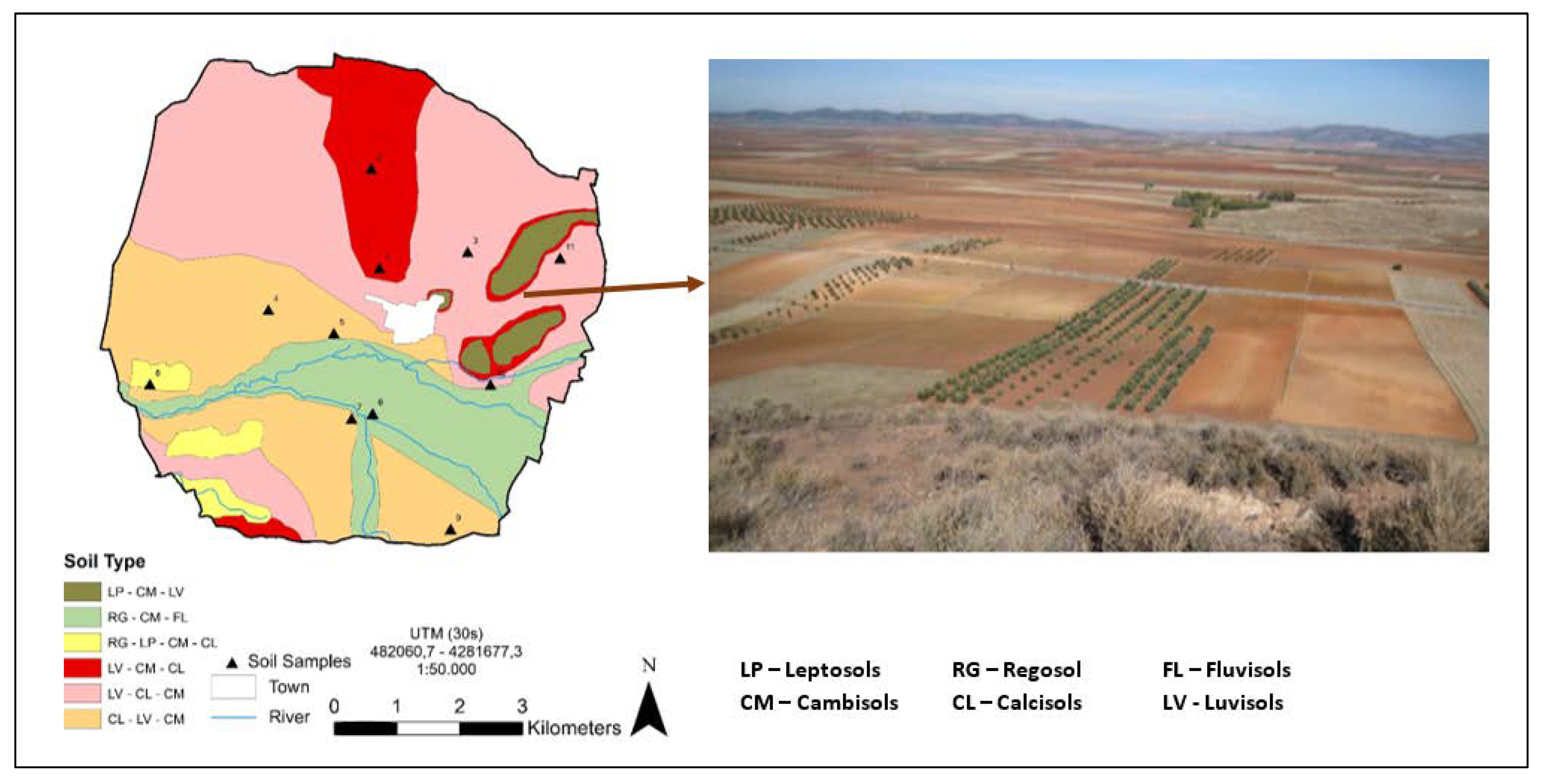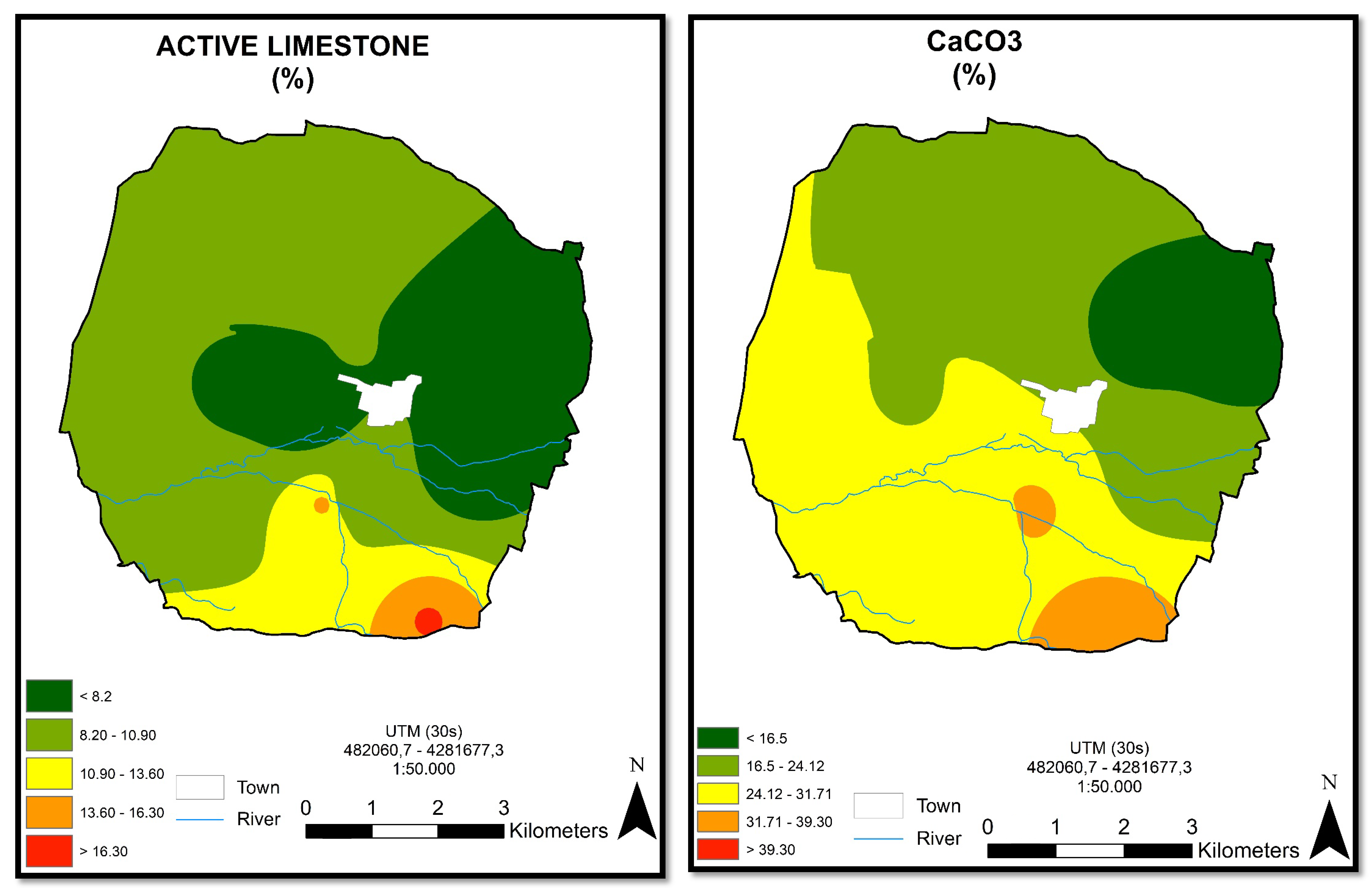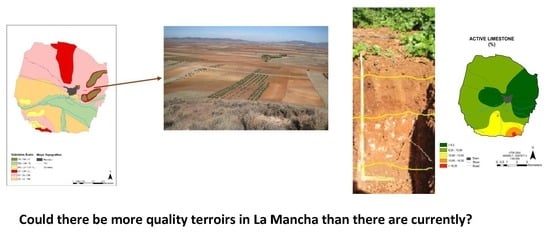Understanding the Quality of Local Vineyard Soils in Distinct Viticultural Areas: A Case Study in Alcubillas (La Mancha, Central Spain)
Abstract
:1. Introduction
2. Materials and Methods
2.1. Study Area
2.2. Soil Mapping and Sampling
2.3. Laboratory Methods
2.4. Statistical Analysis
3. Results
3.1. Soil Surface Characteristics and Soil Mapping
3.2. Soil Texture and Bulk Density
3.3. Other Soil Properties
4. Discussion
5. Conclusions
Author Contributions
Funding
Acknowledgments
Conflicts of Interest
References
- MAGRAMA. Encuesta Sobre Superficie y Rendimientos de Cultivos. Available online: https://www.mapa.gob.es/es/estadistica/temas/estadisticasagrarias/comentariosespana2018_tcm30-503558.pdf (accessed on 25 November 2019).
- Fernández-Marín, M.I.; Guerrero, R.F.; García-Parrilla, M.C.; Puertas, B.; Ramírez, P. Terroir and variety: Two key factors for obtaining stilbene-enriched grapes. J. Food Compos. Anal. 2013, 31, 191–198. [Google Scholar] [CrossRef]
- Seguin, G. “Terroirs” and pedology of wine growing. Experientia 1986, 42, 861–873. [Google Scholar] [CrossRef]
- Van Leewen, C.; Friant, P.; Choné, X.; Tregoat, O.; Koundouras, S.; Dubordieu, D. Influence of Climate, Soil and Cultivar on Terroir. Am. J. Enol. Vitic. 2004, 55, 207–217. [Google Scholar]
- Andrés-de Prado, R.; Yuste, R.M.; Sort, X.; Andrés, L.C.; Torres, M. Effect of soil type on wines produced from Vitis vinifera L. cv. Grenache in commercial vineyards. J. Agric. Food Chem. 2007, 55, 779–786. [Google Scholar]
- Gómez-Míguez, M.J.; Gómez-Míguez, M.; Vicario, I.M.; Heredia, F.J. Assessment of colour and aroma in white wines vinifications: Effects of grape maturity and soil type. J. Food Eng. 2007, 79, 758–764. [Google Scholar] [CrossRef]
- Wang, Y.; Yang, L.; Kong, L.; Liu, E.; Wang, L.; Zhu, J. Spatial distribution, ecological risk assessment and source identification for heavy metals in surface sediments from Dongping Lake, Shandong, East China. Catena 2015, 125, 200–205. [Google Scholar] [CrossRef]
- Amorós, J.A.; Bravo, S.; Sanchez-Ormeño, M.; Violero, M. El problema del hierro en la nutrición de la vid. Agricultura 2019, 1.030, 72–75. [Google Scholar]
- Renouf, V.; Trégoat, O.; Roby, J.P.; Van Leeuwen, C. Soils, rootstocks and grapevine varieties in prestigious Bordeaux vineyards and their impact on yield and quality. J. Int. Sci. Vigne Vin. 2010, 44, 127–134. [Google Scholar] [CrossRef]
- Jackson, D.I.; Lombard, P.B. Environmental and management practices affecting grape composition and wine quality-a review. Am. J. Enol. Vitic. 1993, 44, 409–430. [Google Scholar]
- Cheng, G.; He, Y.N.; Yue, T.X.; Wang, J.; Zhang, Z.W. Effects of climatic conditions and soil properties on cabernet sauvignon berry growth and anthocyanin profiles. Molecules 2014, 19, 13683–13703. [Google Scholar] [CrossRef]
- Pérez-Alvarez, E.; Martínez-Vidaurré, J.M.; Garde-Cerdán, T. Antocyanin composition of grapes from three different soil types in cv. Tempranillo A.O.C. Rioja vineyards. J. Sci. Food Agric. 2019, 99, 4833–4841. [Google Scholar] [CrossRef]
- Chopin, E.I.B.; Marin, B.; Mkoungafoko, R.; Rigaux, A.; Hopgood, M.J.; Delannoy, E.; Cance’s, B.; Laurain, M. Factors affecting distribution and mobility of trace elements (Cu, Pb, Zn) in a perennial grapevine (Vitis vinifera L.) in the Champagne region of France. Environ. Pollut. 2008, 156, 1092–1098. [Google Scholar] [CrossRef] [PubMed]
- Marin, A.; Andrades, M.; Iñigo, V.; y Jiménez-Ballesta, R. Lead and Cadmium in Soils of La Rioja Vineyards, Spain. Land Degrad. Dev. 2016, 27, 1286–1294. [Google Scholar] [CrossRef]
- Amorós, J.A.; Bravo, S.; García-Navarro, F.J.; Pérez-de-los-Reyes, C.; Chacón, J.L.; Martínez, J.; Jiménez-Ballesta, R. Atlas de Suelos de Castilla-La Mancha, 1st ed.; Globalcaja and Universidad de Castilla-La Mancha: Ciudad Real, Spain, 2015; p. 318. [Google Scholar]
- Jiménez-Ballesta, R.; Pérez-de-los-Reyes, C.; Amorós, J.A.; Bravo, S.; Garcia-Navarro, F.J. Pedodiversity in vineyards of Castilla-La Mancha, Spain. In Actas Congress Terroir; Gobierno de Aragón: Zaragoza, Spain, 2018; ISBN 978-84-09-03040-8. [Google Scholar]
- Germán, S.; Larrocha, J.C.; Martin-Gaitero, M.; Solana, J.L.; Escribano, J.A. Registro Vitícola. Castilla-La Mancha. Ciudad Real; J.J.C.C. Castilla-La Mancha: Toledo, Spain, 2008; p. 168. [Google Scholar]
- JCCM. Available online: https://datosabiertos.castillalamancha.es/dataset/municipios-de-castilla-la-mancha/resource/9d9d821f-7d4f-4bcc-aea7-dde41a505615 (accessed on 18 November 2019).
- Winkler, A.J. Viticultura, 1st ed.; Compañia Editorial Continental: Mexico D.F., Mexico, 1965; pp. 85–103. [Google Scholar]
- Hidalgo, L. Tratado de Viticultura General, 3rd ed.; Mundiprensa: Madrid, Spain, 2002; p. 1235. [Google Scholar]
- FAO. Guidelines for Soil Description, 4th ed.; FAO/UNESCO: Rome, Italy, 2006; p. 108. [Google Scholar]
- Peech, M.; Alexander, L.T.; Dean, L.A.; Reed, J.F. Methods of Soil Analysis for Soil Fertility Investigations; USDA: Washington, DC, USA, 1947; p. 25.
- Richards, L.A. Diagnosis and Improvement of Saline and Alkali Soils; U.S. Salinity Laboratory; USDA Hbk: Washington, DC, USA, 1954; p. 160.
- Gee, G.W.; Bauder, J.W. Methods of Soil Analysis. Part 1. Physical and Mineralogical Methods, 2nd ed.; ASA-SSSA: Madison, WI, USA, 1986; pp. 383–411. [Google Scholar]
- Blake, G.R.; Hartge, K.H. Bulk density. In Methods of Soil Analysis, Part 1: Physical and Mineralogical Methods, 2nd ed.; ASA-SSSA: Madison, WI, USA, 1986; pp. 363–382. [Google Scholar]
- Drouineau, G. Dosage rapide du calcaire actif de sols. Ann. Agron. 1942, 12, 441–450. [Google Scholar]
- Nelson, D.W.; Sommers, L.E. Total Carbon, Organic Carbon and Organic Matter; ASA-SSSA: Madison, WI, USA, 1982; pp. 539–579. [Google Scholar]
- Thomas, G.W. Exchangeable Cations. In Methods of Soil Analysis, Part 2; ASA-SSSA: Madison, WI, USA, 1982; pp. 159–165. [Google Scholar]
- Olsen, S.R.; Cole, C.V.; Watanabe, F.S.; Dean, L.A. Estimation of Available Phosphorus in Soils by Extraction with Sodium Bicarbonate; USDA: Washington, DC, USA, 1954; p. 22.
- Bremner, J.M.; Mulvaney, C.S. Nitrogen Total. In Methods of Soil Analysis Part 2, Chemical and Microbiological Properties; ASA-SSSA: Madison, WI, USA, 1982; pp. 621–622. [Google Scholar]
- Soil Survey Staff. Key to Soil Taxonomy, 12th ed.; USDA-Natural Resources, Conservation Service: Washington, DC, USA, 2014; p. 379.
- FAO-ISRIC-ISSS. World Reference Base for Soil Resources; FAO: Rome, Italy, 2006; p. 142. [Google Scholar]
- Jiménez-Ballesta, R.; Alvarez, A.; Gutiérrez, A.; Redondo, E. Consideraciones geoquímicas sobre la presencia de ferricretas al SE de Ciudad Real. Indust. Min. 1989, 293, 33–36. [Google Scholar]
- Jiménez-Ballesta, R.; Alvarez, A.; Gutiérrez, A.; Redondo, E. Composición geoquímica de unas ferricretas en el entorno de un monte isla de Ciudad Real. In Anales de Edafologia y Agrobiologia; CSIC: Madrid, Spain, 1989; Volume 48, pp. 649–664. [Google Scholar]
- Dixon, J.B. Roles of Clays in Soils. Appl. Clay Sci. 1991, 5, 489–503. [Google Scholar] [CrossRef]
- Bravo, S.; Amorós, J.A.; Pérez-De-Los-Reyes, C.; García, F.J.; Moreno, M.M.; Sánchez-Ormeño, M.; Higueras, P. Influence of the soil pH in the uptake and bioaccumulation of heavy metal (Fe, Zn, Cu, Pb and Mn) and other elements (Ca, K, Al Sr and Ba) in vine leaves, Castilla-La Mancha (Spain). J. Geochem. Explor. 2017, 174, 79–83. [Google Scholar] [CrossRef]
- Hidalgo, L. Caracterización Macrofísica del Ecosistema Medio-Planta en los Viñedos Españoles, 1st ed.; I.N.I.A. Comunicaciones: Valencia, Spain, 1980; Volume 29, p. 259. [Google Scholar]
- Carlevalis, J.J.; De La Horra, J.L.; Serrano, F.; Rodriguez, J. La Fertilidad de los Principales Suelos Agrícolas de la Zona Oriental de la Provincia de Ciudad Real. La Mancha y Campo de Montiel, 1st ed.; C.S.I.C. and J.J.C.C. Castilla-La Mancha: Madrid, Spain, 1992; p. 294. [Google Scholar]
- Huglin, P. Biologie et Ecologie de la Vigne, 2nd ed.; Payot Lausanne: Paris, France, 1998; p. 371. [Google Scholar]
- White, R.E. Understanding Vineyard Soils, 2nd ed.; Oxford University Press: Oxford, UK, 2009; p. 280. [Google Scholar]
- Gebreyaw, B.T. Soil quality assessment strategies for evaluating soil degradation in northern Ethiopia. App. Environ. Soil Sci. 2014, 3, 1–14. [Google Scholar]
- Kment, P.; Mihaljevic, M.; Ettler, V.; Sebek, O.; Strnad, L.; Rohlova, L. Differentiation of Czech wines using multielement composition. A comparison with vineyard soil. Food Chem. 2005, 91, 157–165. [Google Scholar] [CrossRef]
- Pepi, S.; Coletta, A.; Crupi, P.; Leis, M.; Russo, S.; Sansone, L.; Tassinaru, R.; Chica, M.; Vaccaro, C. Geochemical characterization of elements in Vitis vinifera cv. Negroamaro grape berries grown under different soil managements. Environ. Monit. Assess. 2016, 188, 211. [Google Scholar] [CrossRef]
- Wilson, J.E. Terroir, the Role of Geology, Climate and Culture in the Making of French Wines, 1st ed.; Mitchell Beazley: London, UK, 1998; p. 336. [Google Scholar]
- Fanet, J. Les Terroirs du Vin; Hachette: Paris, France, 2001. [Google Scholar]
- Morlat, R.; Bodin, F. Characterization of viticultural terroirs using a simple field model based on soil depth—II. Validation of the grape yield and berry quality in the Anjou vineyard (France). Plant Soil 2006, 281, 55–69. [Google Scholar] [CrossRef]
- Bodin, F.; Morlat, R. Characterization of viticultural terroirs using a simple field model based on soil depth—I. Validation of the water supply regime, phenology and vine vigour, in the Anjou vineyard (France). Plant Soil 2006, 281, 37–54. [Google Scholar] [CrossRef]
- Coipel, J.; Rodriguez-Lovelle, B.; Sipp, C.; Van Leeuwen, C. Terroir effect, as a result of environmental stress, depends more on soil depth than on soil type (Vitis vinifera L. cv. Grenache noir, Côtes du Rhône, France, 2000). J. Int. Sci. Vigne Vin. 2006, 40, 177–185. [Google Scholar]



| Soil Property | Basic Procedures | References |
|---|---|---|
| pH | Potentiometrically measured in 1:2.5 soil/water suspension, pH meter | [22] |
| EC | Salinity measured in 1:5 soil/water suspension, EC meter | [23] |
| Texture | Hygrometer method | [24] |
| Bulk density | Determined by the cylinder method | [25] |
| CaCO3 | Determination by the Bernard method, calcimeter | |
| Active Limestone | Determination by ammonium oxalate | [26] |
| OM | Determination by dichromate digestion (Walkley and Black method | [27] |
| CEC | Percolation of a 1.0 mol/L ammonium acetate solution, pH = 7 | [28] |
| P | Determination by the Olsen method | [29] |
| N | Determination by the Kjeldahl method | [30] |
| Major and trace elements | Determination by FRX |
| Soil Hor. | Statistics | pH (1:2.5) | EC (dS/m) | CaCO3 | Active CaCO3 | OM | Sand | Silt | Clay | Bulk Density (g/cc) | N (%) | P (mg/kg) | CEC | Ca | Mg | Na | K | V% (%) |
|---|---|---|---|---|---|---|---|---|---|---|---|---|---|---|---|---|---|---|
| (%) | (cmol+/kg) | |||||||||||||||||
| Ap | Mean | 8.4 | 0.20 | 23.7 | 9.13 | 1.39 | 47.1 | 36.2 | 16.6 | 1.23 | 0.06 | 11.2 | 17.6 | 16.84 | 0.45 | 0.09 | 0.2 | 100 |
| Max | 8.7 | 0.35 | 38.4 | 16.6 | 2.2 | 59.7 | 50.3 | 25.9 | 1.78 | 0.08 | 14.2 | 23.5 | 22.3 | 0.9 | 0.1 | 0.3 | 100 | |
| Min | 8.2 | 0.09 | 8.9 | 5.5 | 0.7 | 35.1 | 24.7 | 7.6 | 0.9 | 0.03 | 9.2 | 13.9 | 13.4 | 0.2 | 0 | 0.1 | 100 | |
| SD | 0.14 | 0.08 | 8.5 | 3.31 | 0.46 | 8.13 | 6.10 | 5.39 | 0.24 | 0.02 | 1.5 | 2.,96 | 2.78 | 0.17 | 0.03 | 01 | 0 | |
| Bt or Bw | Mean | 8.5 | 0.14 | 26.9 | 10.26 | 1.04 | 38.86 | 33.29 | 27.88 | 1.49 | 0.04 | 10.1 | 19.9 | 19.13 | 0.64 | 0.09 | 0.2 | 100 |
| Max | 8.7 | 0.19 | 48.7 | 16.7 | 1.6 | 61.6 | 44.7 | 36.6 | 1.88 | 0.06 | 13.3 | 29.1 | 27.6 | 1.2 | 0.1 | 0.4 | 100 | |
| Min | 8.2 | 0.10 | 16.5 | 5.5 | 0.5 | 19.3 | 21.2 | 17.2 | 1.26 | 0.03 | 7.8 | 12.5 | 11.8 | 0.3 | 0 | 0.1 | 100 | |
| SD | 0.14 | 0.02 | 10.7 | 3.61 | 0.38 | 11.87 | 8.05 | 7.44 | 0.23 | 0.01 | 1.4 | 4.67 | 4.42 | 0.25 | 0.03 | 0.1 | 0 | |
| Soil Map Unit | FAO | Soil Taxonomy |
|---|---|---|
| 1 | LP CM LV | Entisol Inceptisol Alfisol |
| 2 | CM RG FL | Inceptisol Entisol |
| 3 | RG CM LP CL | Entisol Inceptisol |
| 4 | LV CM CL | Alfisol Inceptisol |
| 5 | LV CL CM | Alfisol Inceptisol |
| 6 | CL LV CM | Inceptisol Alfisol |
© 2020 by the authors. Licensee MDPI, Basel, Switzerland. This article is an open access article distributed under the terms and conditions of the Creative Commons Attribution (CC BY) license (http://creativecommons.org/licenses/by/4.0/).
Share and Cite
Jiménez-Ballesta, R.; Bravo, S.; Amorós, J.A.; Pérez-de los Reyes, C.; García-Pradas, J.; García-Navarro, F.J. Understanding the Quality of Local Vineyard Soils in Distinct Viticultural Areas: A Case Study in Alcubillas (La Mancha, Central Spain). Agriculture 2020, 10, 66. https://doi.org/10.3390/agriculture10030066
Jiménez-Ballesta R, Bravo S, Amorós JA, Pérez-de los Reyes C, García-Pradas J, García-Navarro FJ. Understanding the Quality of Local Vineyard Soils in Distinct Viticultural Areas: A Case Study in Alcubillas (La Mancha, Central Spain). Agriculture. 2020; 10(3):66. https://doi.org/10.3390/agriculture10030066
Chicago/Turabian StyleJiménez-Ballesta, Raimundo, Sandra Bravo, José Angel Amorós, Caridad Pérez-de los Reyes, Jesús García-Pradas, and Francisco J. García-Navarro. 2020. "Understanding the Quality of Local Vineyard Soils in Distinct Viticultural Areas: A Case Study in Alcubillas (La Mancha, Central Spain)" Agriculture 10, no. 3: 66. https://doi.org/10.3390/agriculture10030066
APA StyleJiménez-Ballesta, R., Bravo, S., Amorós, J. A., Pérez-de los Reyes, C., García-Pradas, J., & García-Navarro, F. J. (2020). Understanding the Quality of Local Vineyard Soils in Distinct Viticultural Areas: A Case Study in Alcubillas (La Mancha, Central Spain). Agriculture, 10(3), 66. https://doi.org/10.3390/agriculture10030066







